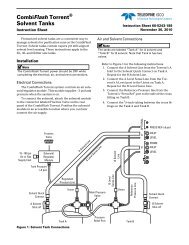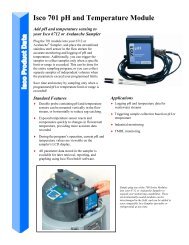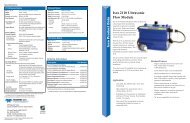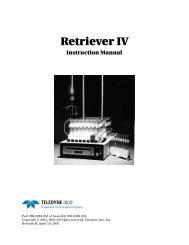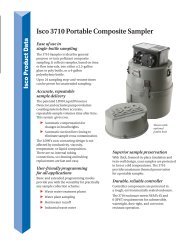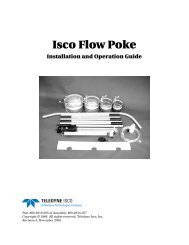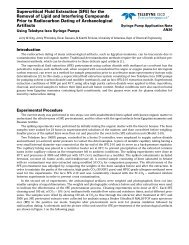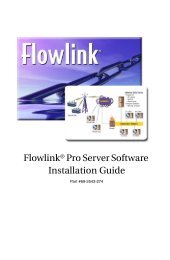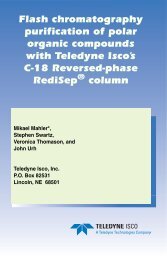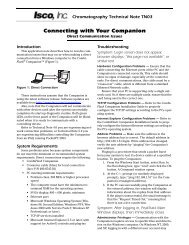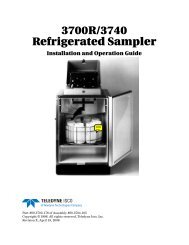Flowcell Care and Cleaning for the CombiFlash Companion - Isco
Flowcell Care and Cleaning for the CombiFlash Companion - Isco
Flowcell Care and Cleaning for the CombiFlash Companion - Isco
Create successful ePaper yourself
Turn your PDF publications into a flip-book with our unique Google optimized e-Paper software.
<strong>Flowcell</strong> <strong>Care</strong> <strong>and</strong> <strong>Cleaning</strong><strong>for</strong> <strong>the</strong> <strong>CombiFlash</strong> ® <strong>Companion</strong> ®Chromatography Technical NoteTN01OverviewFor optimum per<strong>for</strong>mance, <strong>the</strong> <strong>CombiFlash</strong> <strong>Companion</strong>detector flowcell must be clear of anyobstructions or build-up of residual sample material.Such problems primarily result from low solventpolarity. When solvent polarity is too low, compoundsmay precipitate or sample material may not be flushedfrom <strong>the</strong> system be<strong>for</strong>e <strong>the</strong> next purification.If <strong>the</strong> flowcell is obstructed, or per<strong>for</strong>ms poorly as aresult of residual compounds, <strong>the</strong> <strong>Companion</strong> displaysan error message. The error message identifies <strong>the</strong> fault<strong>and</strong> prompts <strong>the</strong> user <strong>for</strong> a response be<strong>for</strong>e continuingwith <strong>the</strong> run.This technical note describes <strong>the</strong> error messages<strong>and</strong> corrective actions, <strong>and</strong> advises of measures thatcan prevent <strong>the</strong> fault conditions.<strong>Flowcell</strong> Error Messages<strong>Flowcell</strong> cleaning is recommended. Continued operationwithout cleaning may result in a noisy trace.If <strong>the</strong> flowcell is partially obstructed <strong>the</strong> above messageis displayed. Continuing to operate <strong>the</strong> systemwithout servicing <strong>the</strong> flow cell may cause excessivenoise in <strong>the</strong> trace (see Figure 1) or reduce amplitude ofabsorbing species.Figure 1: Noisy traceThe detector lamp is not on. You can continue <strong>the</strong>separation without detection, or cancel. 280@81When <strong>the</strong> above message occurs at <strong>the</strong> beginning ofa run, ei<strong>the</strong>r <strong>the</strong> lamp is not working at all, or <strong>the</strong> flowcell is blocked to a degree that <strong>the</strong> detector is notreceiving adequate light. The number preceding <strong>the</strong> “@”symbol at <strong>the</strong> end of <strong>the</strong> message indicates which of <strong>the</strong>two faults is likely.● ≤ 200: Contact <strong>Isco</strong> Technical Service. The lampmay not be working at all.● > 200: The lamp is working but <strong>the</strong> flow cellrequires cleaning.In <strong>the</strong> example <strong>the</strong> number is 280, indicating that <strong>the</strong>flow cell should be cleaned.<strong>Flowcell</strong> <strong>Cleaning</strong> SolventsThe flowcell can be cleaned by pumping a solventthrough <strong>the</strong> system. Generally, <strong>the</strong> recommended solventis <strong>the</strong> highest polarity solvent you have recentlyused. There<strong>for</strong>e, ethyl acetate (often solvent B) wouldbe used. See Table 1 <strong>for</strong> alternative solvents. Recent syn<strong>the</strong>sissolvents should also be considered.Table 1: Suggested Flow Cell <strong>Cleaning</strong>Solvents aSolventMethanolAcetoneDichloromethane(DCM)Dimethylsulfoxide(DMSO)Dimethyl<strong>for</strong>mamide(DMF)Tetrahydrofuran(THF)Mildly acidicaqueous solutionMildly basicaqueous solutionDescriptionMiscible with most LC solvents. It will <strong>for</strong>ce o<strong>the</strong>r solventsthrough <strong>the</strong> system so that <strong>the</strong>y will not interfere with <strong>the</strong>next sample. Breaks down <strong>the</strong> tertiary structure of silica<strong>and</strong> allows it to flush through.Common organic solvent with high dissolving properties.Effective at solubilizing organic molecules.Strong solvent that will clear organic sample.Strong solvent if o<strong>the</strong>r solvents do not produce <strong>the</strong> desiredresults.Strong solvent.0.5M acetic acid in distilled water can be used to clearsamples that are not removed by organic solvents.A dish-type detergent solution can wash through particulatesnot picked up by <strong>the</strong> acidic solution. The emulsificationeffect of detergent is an effective tool as well to helpwash through oily samples. Follow <strong>the</strong> detergent with severalminutes of clean, distilled water.a. Always h<strong>and</strong>le solvents in accordance with <strong>the</strong> manufacturer’s orsupplier’s MSDS.Quick <strong>Flowcell</strong> <strong>Cleaning</strong>Quick cleaning is advantageous because very littlesolvent is required <strong>and</strong> repriming is not necessary. Toquick clean <strong>the</strong> system:1. Remove <strong>the</strong> column from <strong>the</strong> system.2. With a syringe, inject <strong>the</strong> selected solvent into<strong>the</strong> lower column mount.3. Insert a bypass tube in place of <strong>the</strong> column.4. From <strong>the</strong> PeakTrak menu select <strong>the</strong> Tools>ManualControl… comm<strong>and</strong> <strong>and</strong> pump 100 mL of SolventA at 100 mL/min.5. Replace <strong>the</strong> bypass tube with a column <strong>and</strong> starta run. The <strong>Companion</strong> will attempt to calibrate<strong>the</strong> flow cell.
Chromatography Technical Note TN01❍❍If <strong>the</strong> calibration is successful, <strong>the</strong> system isready <strong>for</strong> use.If <strong>the</strong> alert message persists, refer to <strong>the</strong> thoroughflowcell cleaning solvents <strong>and</strong> techniques.Thorough <strong>Flowcell</strong> <strong>Cleaning</strong>To thoroughly clean <strong>the</strong> flowcell:1. Remove <strong>the</strong> column from <strong>the</strong> system <strong>and</strong> insert abypass tube.2. If using an alternative solvent, place <strong>the</strong> solventinlet line into a container of <strong>the</strong> selected solvent.3. Pump 100 ml of solvent through <strong>the</strong> system at100 mL/min.4. If an alternative solvent was used, return <strong>the</strong> solventinlet line to <strong>the</strong> appropriate solvent container.5. Select <strong>the</strong> Tools>Auto Prime menu comm<strong>and</strong> toprime <strong>the</strong> system.6. Replace <strong>the</strong> bypass tube with a column <strong>and</strong> starta run. The <strong>Companion</strong> will attempt to calibrate<strong>the</strong> flow cell.❍ If <strong>the</strong> calibration is successful, <strong>the</strong> system isready <strong>for</strong> use.❍ If <strong>the</strong> alert message persists, refer to <strong>the</strong> alternativeflow cell cleaning solvents <strong>and</strong> techniques.The solvent strength <strong>and</strong> high flow rate will typicallyclear <strong>the</strong> obstruction <strong>and</strong> return <strong>the</strong> flow cell tooptimum per<strong>for</strong>mance.Alternative <strong>Cleaning</strong> TechniquesIf <strong>the</strong> thorough flow cell cleaning instructions do notclear <strong>the</strong> obstruction, <strong>the</strong> following alternative techniquesshould be considered.● Pump water/DMF/methanol (50/25/25) <strong>for</strong> 3–4minutes followed by pumping straight methanol(or ethanol) <strong>for</strong> 2–3 minutes.●●Pump 5–10 mL DMSO followed by methanol,ethyl acetate, <strong>the</strong>n hexane.After <strong>the</strong> lines have been filled with solvent,reduce <strong>the</strong> flow rate or pause up to 18 hours.Doing so will allow <strong>the</strong> solvent to remain longerto dissolve <strong>the</strong> obstruction.Preventive careOften <strong>the</strong> only maintenance required is to operate<strong>the</strong> instrument with a bypass tube in place at a high flowrate with a high polarity solvent.With typical gradient configurations under normalphase conditions, <strong>the</strong> B solvent has <strong>the</strong> highest polarity.Adding a high percentage of B solvent (much higherthan is necessary to elute <strong>the</strong> sample) at <strong>the</strong> end of <strong>the</strong>separation ensures that all of <strong>the</strong> sample material isflushed through <strong>the</strong> flowcell. This can be added to <strong>the</strong><strong>Companion</strong>’s default methods so that flowcell cleaningoccurs every run (see Figure 2).Gradient % Solvent B1007550250Initial %BSeparationGradientEnd ofSeparation<strong>Flowcell</strong> <strong>and</strong>ColumnFlushTime or Column VolumesFigure 2: <strong>Flowcell</strong> flushing at end of runEnd ofRunEquilibrate/Next Initial %BSummaryA clean flowcell ensures optimum peak detectionper<strong>for</strong>mance.Pumping a high polarity solvent through <strong>the</strong> systemat <strong>the</strong> end of each run may prevent flow cell problems.If <strong>the</strong> <strong>Companion</strong> does detect a flow cell problem,determine <strong>the</strong> cause according to <strong>the</strong> displayed errormessage, <strong>the</strong>n follow through with <strong>the</strong> recommendedcorrective action as soon as possible.Last modified July 15, 2005Teledyne <strong>Isco</strong>, Inc.P.O. Box 82531, Lincoln, Nebraska, 68501 USAToll-free: (800) 775-2965 • Phone: (402) 464-0231 • Fax: (402) 465-3001E-mail: service@isco.com



